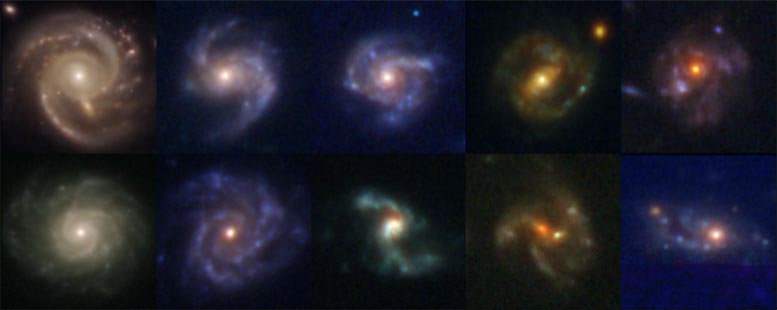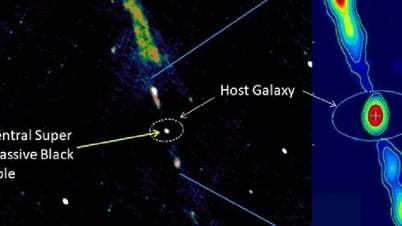(NLDO) - Unexpected discoveries from data from the James Webb super telescope have overturned long-held cosmological theories.
A team of scientists led by the University of Missouri (USA) analyzed data collected by the world's most powerful space telescope, James Webb, about the universe in the first 2 billion years after the Big Bang and discovered something unexpected: a spiral galaxy.
According to accepted cosmological theories, the early universe was a monotonous and slowly evolving region of space, with the first galaxies having simple structures and small sizes.
Large, complex spiral galaxies - the same type as the Milky Way galaxy that Earth resides in - only appeared when the universe was 6-7 billion years old.

Spiral galaxies found in the early universe have shapes not too different from the Milky Way - Photo: NASA/ESA/CSA
However, new "time-traveling" images of a series of galaxies that existed long before that time have been completely shocking.
Having just been operational since 2022, the young James Webb telescope, jointly operated by the US, European and Canadian space agencies, has more observational power than its "senior" space telescopes.
The light that forms an image of an object takes a time proportional to its distance to reach this telescope orbiting the Earth.
So, if James Webb "looks" far enough, it will see past objects in the state and position they existed billions of years ago.
Spiral galaxies in this case are the same.
According to SciTech Daily, recent data from James Webb shows that in the space 2 billion years after the Big Bang, up to 30% of galaxies are spiral galaxies.
This pushes back the time when this type of galaxy first began to form in the universe by 4-5 billion years earlier than previously thought.
The spiral "arms" of galaxies are a fundamental feature that astronomers use to classify galaxies and understand how they form over time, said co-author Professor Yicheng Guo.
While we still have many questions about the universe's past, analyzing this data helps us uncover more clues and gain deeper understanding of the physics that shaped the nature of the universe.
This discovery adds to a series of recent findings - dating back to James Webb - that the universe's first few billion years may have evolved much more rapidly than we thought.
And this requires not only rewriting the history of the universe, but also rewriting the history of the very world we inhabit.
Our Milky Way galaxy may have a longer, more complex, more wild history than we once thought.
Source: https://nld.com.vn/vat-the-xuyen-khong-11-ti-nam-viet-lai-lich-su-vu-tru-196240707085139113.htm





![[Photo] Vietnam and Sri Lanka sign cooperation agreements in many important fields](https://vphoto.vietnam.vn/thumb/1200x675/vietnam/resource/IMAGE/2025/5/5/9d5c9d2cb45e413c91a4b4067947b8c8)

























![[Photo] President Luong Cuong and Sri Lankan President Anura Kumara Dissanayaka visit President Ho Chi Minh relic site](https://vphoto.vietnam.vn/thumb/1200x675/vietnam/resource/IMAGE/2025/5/5/0ff75a6ffec545cf8f9538e2c1f7f87a)


































![[Photo] President Luong Cuong presided over the welcoming ceremony and held talks with Sri Lankan President Anura Kumara Dissanayaka](https://vphoto.vietnam.vn/thumb/402x226/vietnam/resource/IMAGE/2025/5/5/351b51d72a67458dbd73485caefb7dfb)


































Comment (0)